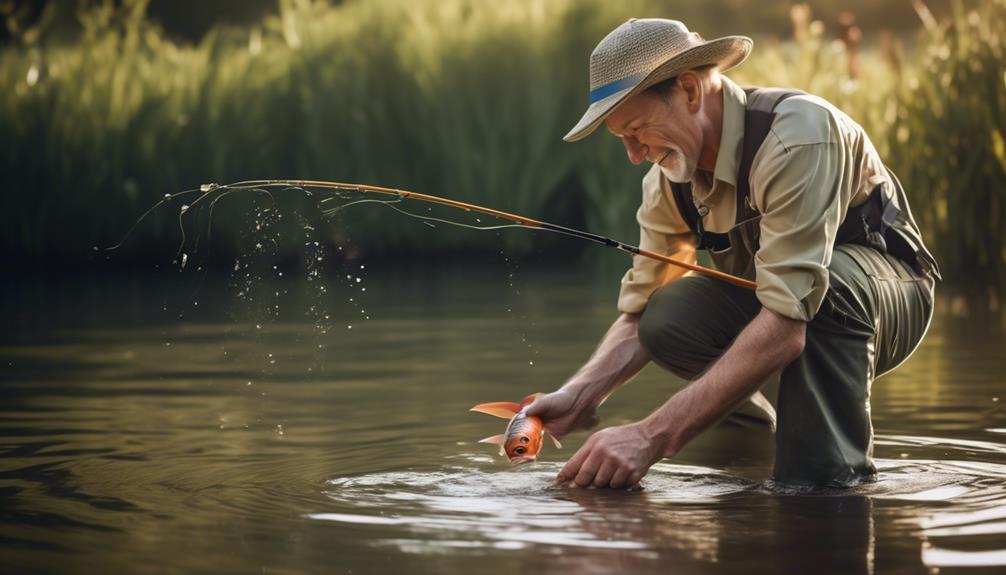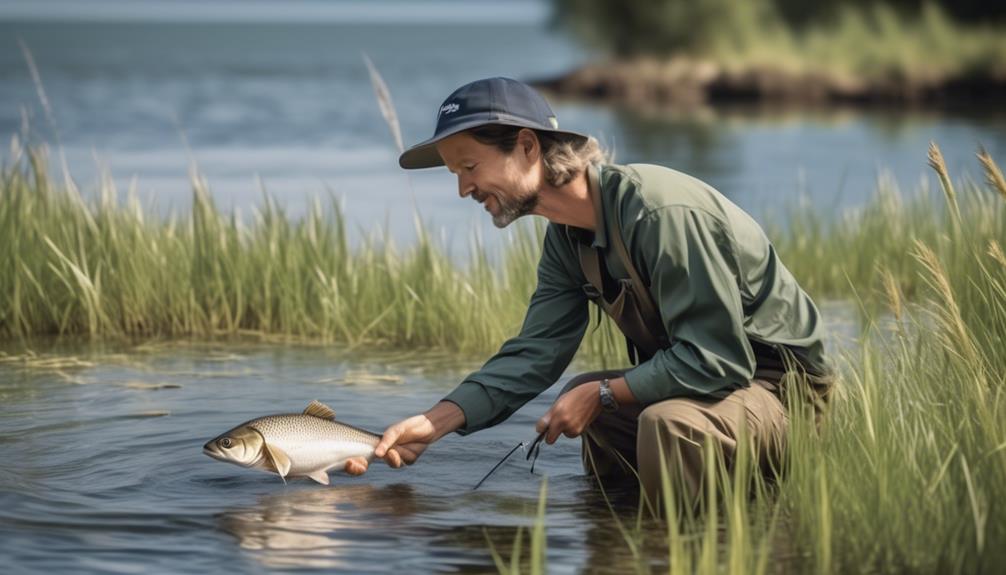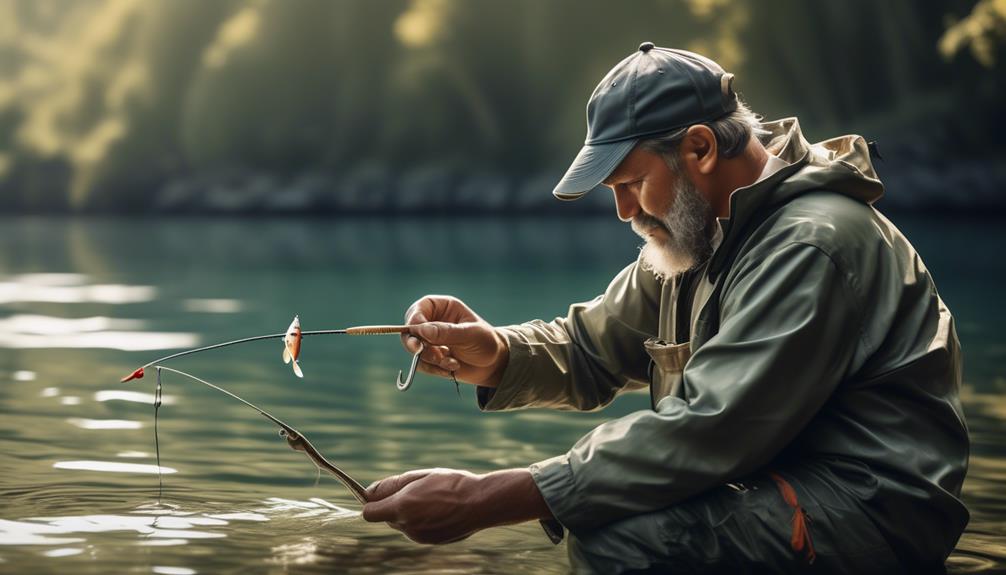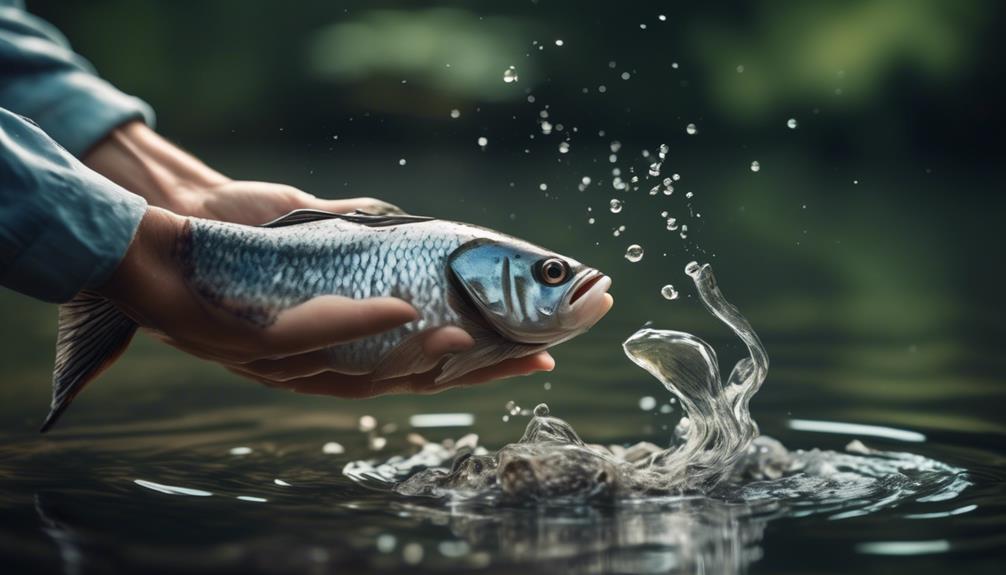When you first start fishing, you may wonder why catch and release is ethical. It's a question many new anglers ask, and the answer lies in the impact it has on fish populations and the environment.
But it's not just about releasing a fish back into the water—it's about understanding the responsibility that comes with being an angler. As you cast your line and feel the tug of a bite, you'll start to realize the importance of proper catch and release techniques and how they contribute to the conservation and sustainability of our natural resources.
But there's more to it than just that.
Benefits of Catch and Release
Catch and release fishing allows anglers to contribute to the sustainability of fish populations while still enjoying the thrill of the sport. This method has a positive environmental impact as it helps maintain healthy fish populations. By releasing fish back into the water, anglers ensure that fish stocks remain stable, and the ecosystem stays balanced. This ethical responsibility is crucial for preserving marine life for future generations.
When anglers practice catch and release, they actively participate in conserving fish populations and protecting the aquatic environment. By releasing fish unharmed, anglers can help maintain the natural balance of species in the water. This approach minimizes the impact on fish populations, allowing them to thrive and reproduce, ultimately supporting the overall health of the ecosystem.
Furthermore, catch and release fishing promotes ethical responsibility by prioritizing the well-being of the fish. Anglers who engage in catch and release understand the importance of treating fish humanely and minimizing harm to their natural habitat. By adopting this approach, anglers demonstrate a commitment to conservation and environmental stewardship, ensuring that fish populations remain robust for the benefit of future generations.
Impact on Fish Population
Contributing to the sustainability of fish populations through catch and release fishing not only maintains healthy stocks but also minimizes the impact on the ecosystem, ensuring the continuation of a balanced aquatic environment.
Fish conservation is a critical aspect of maintaining the delicate balance within aquatic ecosystems. When anglers practice catch and release, they directly contribute to fish conservation efforts. By releasing fish back into their natural habitat, anglers help in the population management of various fish species. This approach ensures that there's minimal disruption to the natural population levels, allowing fish stocks to remain stable and sustainable.
Catch and release fishing plays a significant role in managing fish populations. It enables the survival of juvenile and breeding fish, thereby supporting the replenishment of fish stocks. This practice is especially crucial for species that are vulnerable or experiencing population declines. By releasing these fish, anglers assist in maintaining the overall health and genetic diversity of fish populations.
Moreover, catch and release fishing aids in controlling the population of certain fish species in specific habitats. By selectively releasing fish, anglers can help prevent overpopulation, which can lead to competition for resources and negatively impact other aquatic species. This management of fish population dynamics is essential for the overall health and equilibrium of aquatic ecosystems.
Therefore, by participating in catch and release fishing, you actively contribute to the conservation and management of fish populations, ensuring a sustainable and thriving aquatic environment for future generations.
Proper Catch and Release Techniques
To ensure the well-being of the fish you catch and release, employ proper handling techniques that minimize stress and injury. Proper catch and release techniques not only increase the chances of fish survival but also reduce the environmental impact of angling. Here are some essential tips to consider:
- Minimize Air Exposure: Limiting the time a fish spends out of the water is crucial. Excessive air exposure can lead to stress and reduce a fish's chance of survival.
- Use Barbless Hooks: Barbless hooks are easier to remove, causing less damage to the fish's mouth and reducing handling time, which is vital for fish survival.
- Handle with Care: Wet your hands before handling a fish to protect its delicate slime layer, which acts as a protective barrier against infections. Avoid squeezing the fish and support its body properly.
- Revive Before Release: If the fish seems exhausted after the fight, hold it upright underwater, allowing water to flow through its gills. Once it shows signs of strength, gently release it.
- Choose Proper Release Methods: Depending on the fish species and size, consider different release methods such as gently releasing the fish near the water's edge or using a release tool for deep-water species.
Conservation and Sustainability
Implementing sustainable angling practices is essential for preserving fish populations and maintaining the health of aquatic ecosystems. As a new angler, it's crucial to understand the impact of your actions on the environment. By practicing ethical catch and release techniques, you contribute to ecosystem balance and ensure the sustainability of fish populations for future generations.
Ethical practices in angling involve being mindful of the fish you catch and release. This means using proper handling techniques and gear to minimize harm to the fish. By doing so, you help maintain the delicate balance within aquatic ecosystems. When fish populations are kept at healthy levels, their role in controlling prey species and maintaining biodiversity is preserved, ultimately contributing to the overall health of the ecosystem.
Conservation isn't just about protecting fish populations; it's also about safeguarding the habitats they rely on. By releasing fish unharmed, you allow them to continue contributing to their natural environment. This is particularly important for maintaining the balance within aquatic food chains and ensuring the overall health of water bodies.
As a responsible angler, your ethical practices play a significant role in the conservation and sustainability of fish populations and aquatic ecosystems. By understanding the importance of ecosystem balance and practicing ethical catch and release techniques, you contribute to the long-term health and preservation of our waters.
Ethical Considerations for Anglers
Understanding the ethical considerations for anglers is crucial for maintaining the delicate balance within aquatic ecosystems and preserving fish populations for future generations. As an angler, you have a responsibility to make ethical decisions that minimize harm to fish and their habitats, ensuring the sustainability of fishing for years to come.
When considering the ethical implications of angling, it's important to keep the following points in mind:
- Fish Handling: Always handle fish with care, minimizing stress and injury. Use proper equipment and techniques to ensure the fish's well-being during catch and release.
- Respect for Regulations: Adhere to fishing regulations and size limits to prevent overfishing and support population management efforts.
- Environmental Awareness: Be mindful of your impact on the environment. Avoid damaging aquatic habitats and dispose of waste responsibly.
- Selective Harvesting: If you choose to keep fish for consumption, practice selective harvesting by only taking what you need and avoiding the depletion of vulnerable species.
- Education and Advocacy: Stay informed about conservation issues and advocate for sustainable fishing practices within your angling community.
Importance of Handling Stressful Situations
Handling stressful situations while fishing requires anglers to remain calm and focused in order to minimize harm to the fish and preserve the integrity of the aquatic ecosystem. Stress management is crucial when it comes to catch and release fishing. When a fish is hooked, it experiences a surge of stress hormones, such as cortisol, which can be detrimental to its health. As an angler, it's important to make ethical decisions during these moments to ensure the fish's well-being.
Upon hooking a fish, the first step in stress management is to reel it in as quickly as possible. This minimizes the time it spends fighting and reduces its overall stress levels. Once the fish is brought to the surface, keep it in the water as much as possible to support its breathing and minimize additional stress. Avoid lifting the fish by its gills or jaws, as this can cause injury and further stress. Instead, cradle the fish gently and support its body properly when handling it. This demonstrates ethical decision making and ensures the fish is treated with care and respect throughout the process.
Understanding Fish Welfare

To ensure the welfare of the fish during catch and release, prioritize gentle handling and swift release into the water. Fish stress is a real concern, and the way you handle the fish greatly affects its well-being. Here are some key handling techniques to keep in mind:
- Minimize Air Exposure: Limiting the time a fish spends out of the water can significantly reduce stress. When unhooking the fish, try to keep it in the water as much as possible.
- Use Barbless Hooks: Barbless hooks are easier to remove, causing less damage to the fish's mouth and reducing handling time. This can help lower the overall stress on the fish.
- Avoid Handling with Dry Hands: Wet your hands before handling a fish. This helps protect the fish's delicate slime layer, which is crucial for its overall health.
- Support the Fish: When holding a fish, provide adequate support. Cradling the fish gently can prevent injury and reduce stress during handling.
- Proper Release Technique: Ensure the fish is fully revived before releasing it. Hold the fish upright underwater and wait for it to swim away on its own. This can aid in a successful and less stressful release.
Understanding fish welfare is essential for ethical catch and release practices. By employing these handling techniques, you can minimize fish stress and contribute to the well-being of the fish population.
Role in Preserving the Environment
Limiting the environmental impact of your fishing practices is crucial for preserving the well-being of fish populations and their habitats. When engaging in catch and release, you play a vital role in conservation efforts. By releasing fish back into their natural habitats, you minimize the disturbance to their ecosystems and contribute to the sustainability of fish populations. This ethical approach helps maintain the balance of aquatic environments and supports the overall health of fish species.
By practicing catch and release, you actively reduce the mortality rates of fish caused by human activities. This method allows fish to continue their natural life cycles, which is fundamental for the preservation of their populations. Additionally, it contributes to the biodiversity of aquatic ecosystems, promoting healthier and more resilient environments.
Your decision to release fish back into the water promotes environmental sustainability. It reduces the pressure on fish stocks, allowing for a more balanced and stable ecosystem. As a responsible angler, you become an advocate for the conservation of fish and their habitats. Your actions align with the principles of ethical and sustainable fishing practices, ensuring that future generations can also enjoy the beauty of nature's aquatic world.
Frequently Asked Questions
What Are the Potential Legal Implications of Catch and Release Fishing?
When it comes to catch and release fishing, it's important to consider the potential legal implications. Engaging in this practice without adhering to specific regulations could lead to fines or other legal consequences.
Additionally, it's crucial to be mindful of the environmental impact of catch and release fishing, as certain species may be more vulnerable to the stress of being caught and released.
Always be aware of the laws and guidelines to ensure responsible fishing practices.
How Can Catch and Release Fishing Benefit the Local Economy and Tourism Industry?
Catch and release fishing can benefit the local economy by attracting sustainable tourism. When anglers release fish, it maintains healthy fish populations, ensuring a sustainable resource for future visitors.
This can lead to increased tourism, supporting local businesses like hotels, restaurants, and outdoor outfitters. The conservation-minded approach of catch and release can also enhance the overall natural beauty and appeal of the area, drawing more visitors and boosting the local economy.
Are There Any Potential Negative Effects of Catch and Release on Other Aquatic Species?
When catching and releasing fish, it's important to consider the impact on biodiversity and ethical considerations. Negative effects can include increased stress on fish, potential harm to other species, and disruption of ecosystems. However, conservation efforts, like using barbless hooks and proper handling techniques, can mitigate these issues.
It's crucial to weigh the ethical implications and take steps to minimize negative effects while still enjoying the sport of fishing.
How Can Anglers Ensure That They Are Properly Handling and Releasing Fish to Minimize Stress and Injury?
To properly handle and release fish, ensure you wet your hands before touching them. Use barbless hooks and minimize air exposure. Gentle handling and swift release help minimize stress and injury.
Ethical considerations for sustainable fishing and conservation efforts are crucial. By following catch and release best practices, you contribute to the well-being of aquatic species and the health of their habitats.
What Are Some Common Misconceptions About Catch and Release Fishing and How Can They Be Addressed?
Addressing misconceptions about catch and release fishing is crucial. Many believe that all released fish survive, but survival rates can be impacted by factors like hooking location and fight time. Proper techniques, like using barbless hooks and minimizing air exposure, can help.
Another misconception is that catching the same fish multiple times doesn't harm it, but it can lead to decreased growth and reproductive success.
Understanding these points is essential for responsible catch and release fishing.
Conclusion
So, as a new angler, catch and release is an ethical practice that benefits fish populations, promotes conservation, and demonstrates responsible angling.
By understanding proper techniques and handling stressful situations, you can contribute to the preservation of fish welfare and the environment.
Embracing catch and release not only allows you to enjoy the sport of fishing, but also ensures that future generations can continue to experience the thrill of angling.
Keep up the good work and happy fishing!



